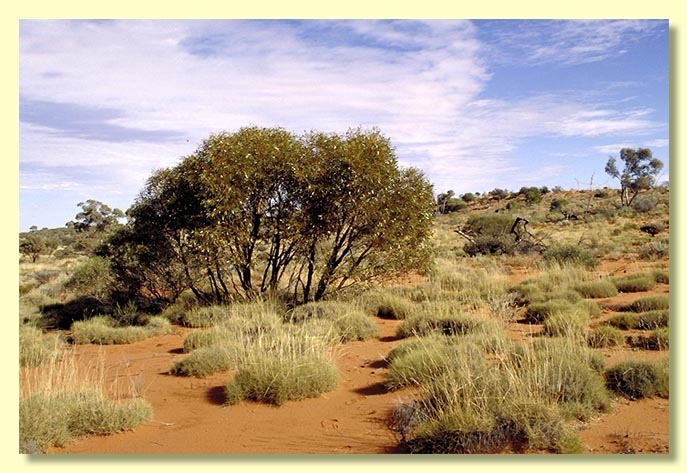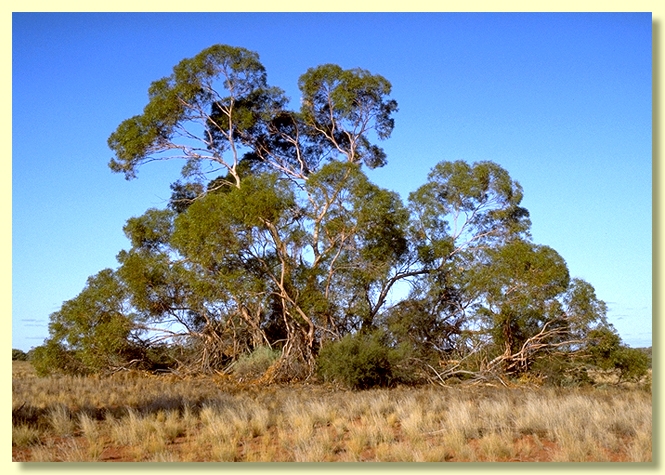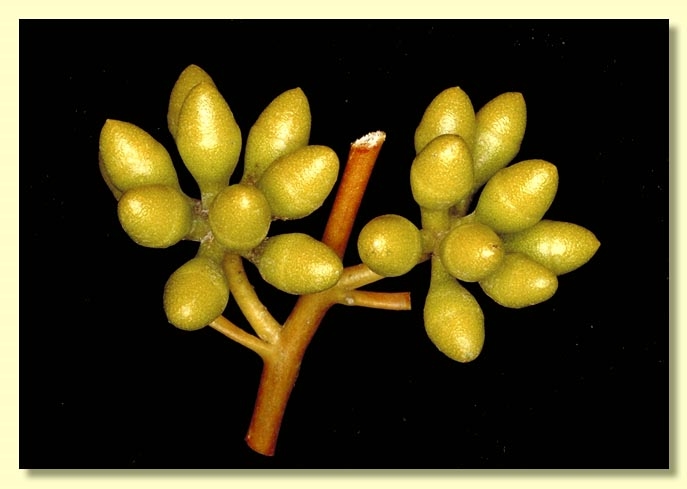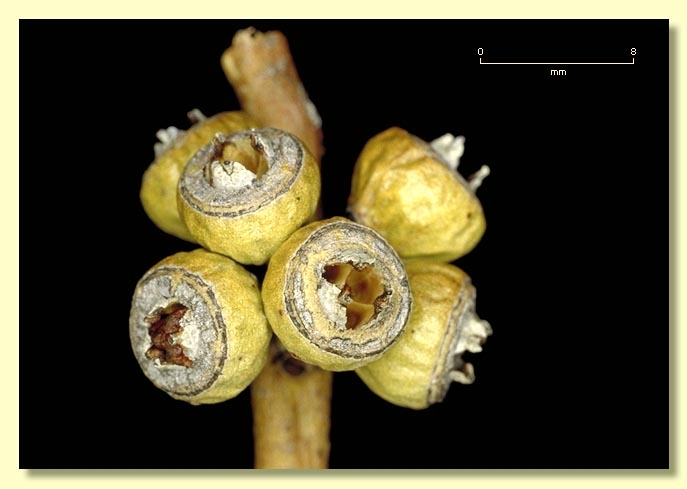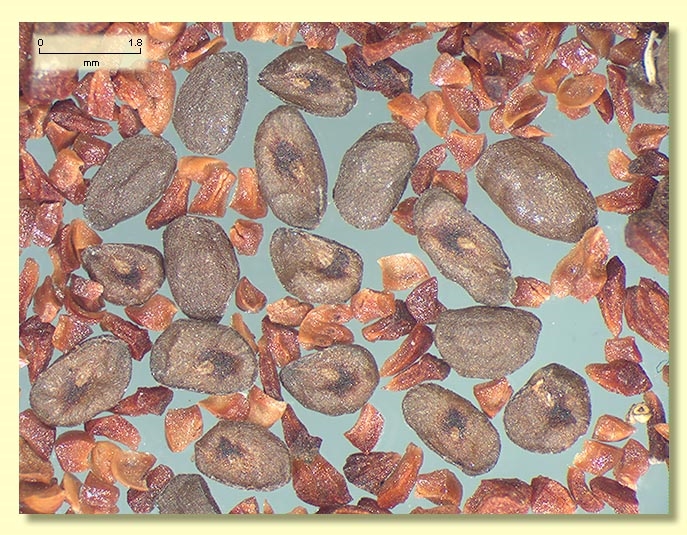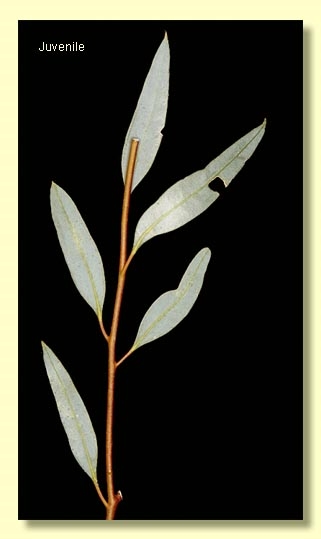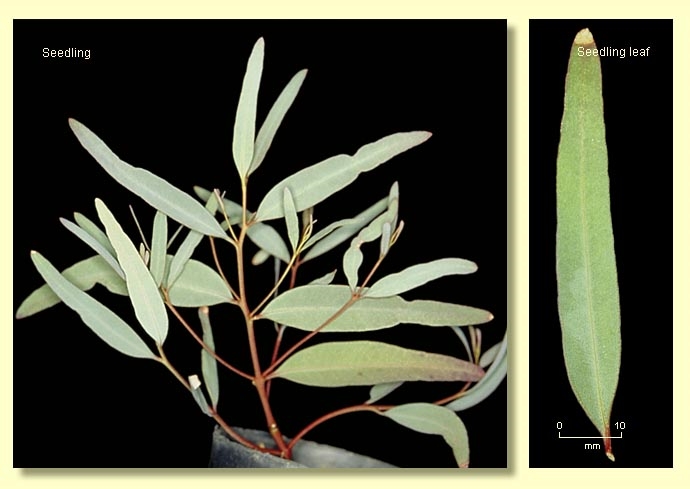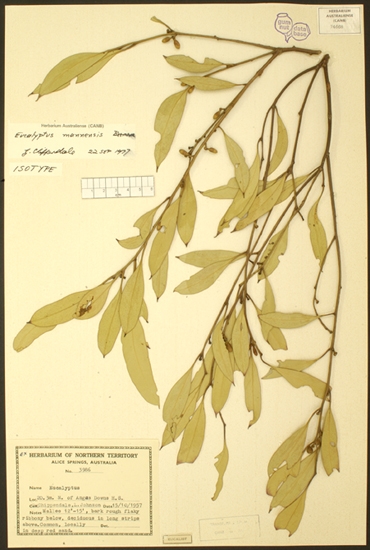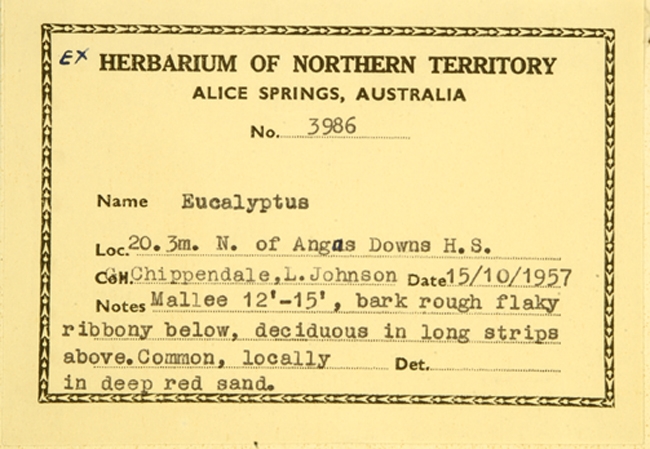Euclid - Online edition
Eucalyptus mannensis subsp. mannensis
Classification
Eucalyptus | Symphyomyrtus | Bisectae | Destitutae | Micrantherae | Bakerianae
Nomenclature
Description
Mallee, rarely a straggly tree, to 10 m tall. Forming a lignotuber.
Bark usually rough for up to 4 m of trunk, grey-brown, flaky and fibrous or loose strips, smooth above or rarely smooth throughout, grey to white.
Branchlets lacking oil glands in the pith.
Juvenile growth (coppice or field seedlings to 50 cm): stems rounded in cross-section; leaves always petiolate, alternate, lanceolate, often narrowly so, 4.5–8.5 cm long, 0.8–2 cm wide, dull, grey-green with a fine point. Leaves green by 1 m tall.
Adult leaves alternate, petioles 0.7–2 cm long; blade narrowly lanceolate to narrowly elliptic, 6.3–11.5 cm long, 0.7–2.3 cm wide, base tapering to petiole, concolorous, very glossy, green, side-veins greater than 45° to midrib, densely reticulate, intramarginal vein close to margin, oil glands conspicuously intersectional.
Inflorescence axillary unbranched, peduncles 0.3–1 cm long, buds 7, 9 or 11, pedicellate (pedicels 0.1–0.5 cm long). Mature buds ovoid (0.5–0.8 cm long, 0.3–0.5 cm wide), scar present, operculum conical, rarely rounded and apiculate, a few outer stamens erect, inner inflexed, anthers oblong to reniform (wider than long), versatile, sub-basifixed, dehiscing by short oblique slits, style long, arising between three prominent lobes on the ovary roof, stigma blunt, locules 3 or 4, the placentae each with 4 vertical ovule rows, ovary roof 3 or 4 lobed at style base with the line of each septum bisecting a lobe. Flowers creamy white.
Fruit pedicellate (pedicels 0.1–0.4 cm long), hemispherical and flat-topped, 0.3–0.6 cm long, 0.5–0.8 cm wide, disc level, valves 3 or 4, each valve with an apical notch often containing part of the base of the style.
Seeds dark brownish grey, 1–2.5 mm long, ovoid or flattened-ovoid, dorsal surface shallowly reticulate, hilum ventral.
Cultivated seedlings (measured at ca node 10): cotyledons Y-shaped (bisected); stems rounded in cross-section; leaves always petiolate, opposite for ca 6–9 nodes then alternate, lanceolate, 5.5–10 cm long, 1–2 cm wide, dull, green to grey-green.
Bark usually rough for up to 4 m of trunk, grey-brown, flaky and fibrous or loose strips, smooth above or rarely smooth throughout, grey to white.
Branchlets lacking oil glands in the pith.
Juvenile growth (coppice or field seedlings to 50 cm): stems rounded in cross-section; leaves always petiolate, alternate, lanceolate, often narrowly so, 4.5–8.5 cm long, 0.8–2 cm wide, dull, grey-green with a fine point. Leaves green by 1 m tall.
Adult leaves alternate, petioles 0.7–2 cm long; blade narrowly lanceolate to narrowly elliptic, 6.3–11.5 cm long, 0.7–2.3 cm wide, base tapering to petiole, concolorous, very glossy, green, side-veins greater than 45° to midrib, densely reticulate, intramarginal vein close to margin, oil glands conspicuously intersectional.
Inflorescence axillary unbranched, peduncles 0.3–1 cm long, buds 7, 9 or 11, pedicellate (pedicels 0.1–0.5 cm long). Mature buds ovoid (0.5–0.8 cm long, 0.3–0.5 cm wide), scar present, operculum conical, rarely rounded and apiculate, a few outer stamens erect, inner inflexed, anthers oblong to reniform (wider than long), versatile, sub-basifixed, dehiscing by short oblique slits, style long, arising between three prominent lobes on the ovary roof, stigma blunt, locules 3 or 4, the placentae each with 4 vertical ovule rows, ovary roof 3 or 4 lobed at style base with the line of each septum bisecting a lobe. Flowers creamy white.
Fruit pedicellate (pedicels 0.1–0.4 cm long), hemispherical and flat-topped, 0.3–0.6 cm long, 0.5–0.8 cm wide, disc level, valves 3 or 4, each valve with an apical notch often containing part of the base of the style.
Seeds dark brownish grey, 1–2.5 mm long, ovoid or flattened-ovoid, dorsal surface shallowly reticulate, hilum ventral.
Cultivated seedlings (measured at ca node 10): cotyledons Y-shaped (bisected); stems rounded in cross-section; leaves always petiolate, opposite for ca 6–9 nodes then alternate, lanceolate, 5.5–10 cm long, 1–2 cm wide, dull, green to grey-green.
Flowering Time
Flowering has been recorded in March, April and August.
Notes
Eucalyptus mannensis is a small to large mallee species scattered and widespread from central Australia, south of the Everard Range in South Australia and west to the Indian Ocean, usually on sandy plains. The bark is rough and the adult leaves are glossy green, with numerous oil glands.
Eucalyptus mannensis belongs in Eucalyptus subgenus Symphyomyrtus section Bisectae subsection Destitutae because buds have two opercula, cotyledons are Y-shaped and branchlets lack oil glands in the pith. Within this subsection E. mannensis is closely related to only three other species, E. micranthera (in Western Australia from near Esperance), E. bakeri (from northern New South Wales and southern Queensland) and E. jutsonii (in Western Australia from north of Kalgoorlie and near Morowa), all of which have a peculiar three-lobed ovary roof in which the base of the style is inserted, and leaves with conspicuous intersectional oil glands.
In its natural distribution E. mannensis is not likely to be confused with any other species because of its glossy green leaves with conspicuous irregular intersectional oil glands, thick-rimmed fruit with exserted "valves" that are minutely three-partite at the tips.
There are two subspecies:
E. mannensis subsp. mannensis
Occurs over the major part of the distribution of the species, i.e. from east of Shark Bay in Western Australia to central Australia. Subsp. mannensis has very glossy adult leaves.
E. mannensis subsp. vespertina
Restricted to sub-coastal Western Australia from Murchison River to Shark Bay area. Subsp. vespertina is weakly distinguished by predominantly narrower adult leaves ( 0.5-1.5 cm wide in subsp. vespertina, 0.7-2.5 cm wide in subsp. mannensis) which are at first dull, blue-green and mature to glossy green.
Eucalyptus mannensis belongs in Eucalyptus subgenus Symphyomyrtus section Bisectae subsection Destitutae because buds have two opercula, cotyledons are Y-shaped and branchlets lack oil glands in the pith. Within this subsection E. mannensis is closely related to only three other species, E. micranthera (in Western Australia from near Esperance), E. bakeri (from northern New South Wales and southern Queensland) and E. jutsonii (in Western Australia from north of Kalgoorlie and near Morowa), all of which have a peculiar three-lobed ovary roof in which the base of the style is inserted, and leaves with conspicuous intersectional oil glands.
In its natural distribution E. mannensis is not likely to be confused with any other species because of its glossy green leaves with conspicuous irregular intersectional oil glands, thick-rimmed fruit with exserted "valves" that are minutely three-partite at the tips.
There are two subspecies:
E. mannensis subsp. mannensis
Occurs over the major part of the distribution of the species, i.e. from east of Shark Bay in Western Australia to central Australia. Subsp. mannensis has very glossy adult leaves.
E. mannensis subsp. vespertina
Restricted to sub-coastal Western Australia from Murchison River to Shark Bay area. Subsp. vespertina is weakly distinguished by predominantly narrower adult leaves ( 0.5-1.5 cm wide in subsp. vespertina, 0.7-2.5 cm wide in subsp. mannensis) which are at first dull, blue-green and mature to glossy green.
Origin of Name
Eucalyptus mannensis: referring to the Mann Range in northern South Australia.
Copyright © CANBR 2020, all rights reserved.

Web edition hosted at https://apps.lucidcentral.org/euclid
